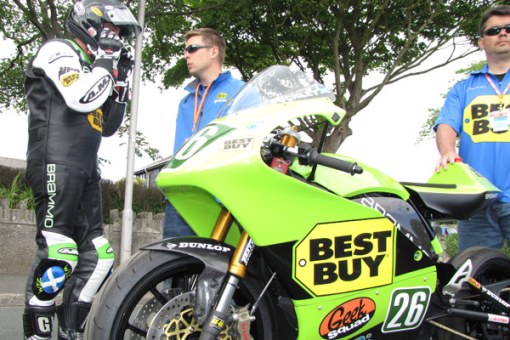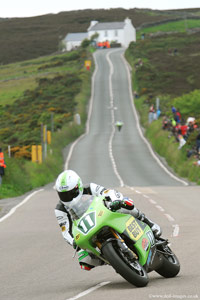
I recently had the opportunity to attend the world’s first sanctioned, all-electric motorcycle race. It was the TTXGP event at the 102nd running of the Isle of Man TT.
The TT in itself is amazing– something everyone should see. It originated in the days when there were no racetracks. If you wanted to race, you closed roads and raced there. It is one of the last races of this type with a 37.73-mile course winding around the British island. There are relatively few slow corners. Most of a lap is spent at top speed winding through small towns on narrow roads lined with stone walls that are many centuries old.
Run during the two weeks of racing was a special event for zero-emission motorcycles. All of the entrants ended up being battery-powered and electric-motor-driven. They consisted of regular streetbikes with electric motors unattractively shoe-horned in, like the race winning Agni, or purpose-built electric racers like the Mission One or the gorgeous Brammo Enertia TTRs. Presentation ranged from the MotoGP-spec pit and equipment of Brammo and Mission to bikes that literally were built in a barn and looked like it.
The atmosphere in the paddock was refreshing and one of how racing used to be. Teams helped each other conquer the challenges of the new technology, and they socialized and dined together in the evenings. Innovation abounded with many different takes on what would make a fast electric motorcycle. All the bikes looked unique– not like the same bikes with different paint, as is the case with modern races.
But the treat was the performance. In the technology’s racing debut, these motorcycles faced the world’s most challenging race circuit, and they came out looking good. Top speeds were consistently over 100 mph with the fastest average-lap speeds about 80. And spectators commented they looked as fast through the corners as any bikes that ran during the TT weeks. Critics were quick to point out that these were speeds of bikes from the 1930s, but judging from the increase in performance from these bikes just during the week, they are going to be much faster next year.
Critics also lamented the lack of loud noise from the bikes. They have a barely-noticeable whine in lieu of the traditional 100 db screaming that challenges motorcycling’s acceptance with the public.
But with this lack of noise I heard something that I have never heard at a motorcycle race– the fans. As the bikes flew through the small towns fans would scream, cheer and clap– and you could hear it! With as impressive and responsible as this race was, this cheering will only grow louder.